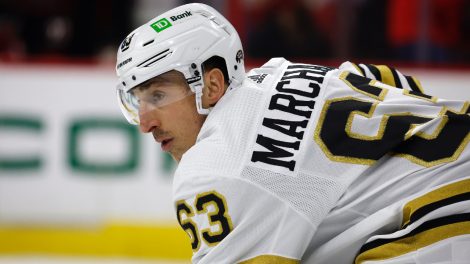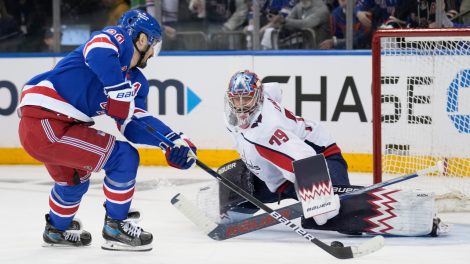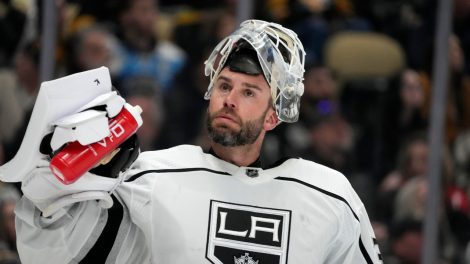Prime Minister Justin Trudeau raised some eyebrows recently when he suggested that the entire country should be rooting for the Ottawa Senators. They’re Canada’s last remaining playoff team, after all, and with the nation riding a Stanley Cup drought going on 24 years, surely we could all unite in a common cause of rooting them on.
Not so fast, responded hockey fans around the country. Once we were done being thankful that this is what passes for a controversial statement from our leader, the backlash to Trudeau’s comments was swift.
The whole “Canada’s team” thing always comes up around this time of year, and it always divides fans. Many are on Trudeau’s side, happily throwing their support behind whichever of the country’s teams is the last one left. But others want no part of switching allegiances, even temporarily. For those fans, the idea of getting behind some other team is a non-starter, and anyone who’d suggest otherwise doesn’t get what being a fan is all about.
We’ll save that particular debate for another day. Instead, let’s take a look back at the teams that have laid claim to “Canada’s Team” status over the years. Since the start of the country’s Cup drought in 1993, there have been 11 Canadian teams that have made it to at least the conference finals as the nation’s last remaining team.
Today, we’ll rank them from least to most likable and see where this year’s Senators would slot in if (and we emphasize the “if”) you were the sort of fan who’d jump on the bandwagon of the country’s last remaining team.
#11. 2011 Canucks
The good: There’s a strong case to be made that this was the country’s very best team of the Cup drought era. They finished the season with 117 points, the most by a Canadian team in 22 years, and earned the first of back-to-back Presidents’ Trophies. They barely survived their first-round series against the Blackhawks, nearly blowing a 3-0 series lead before winning Game 7 in overtime, and seemed to get stronger as the playoffs wore on. By the time a Stanley Cup final matchup with the Bruins arrived, it really did seem like this was going to be the Canucks’ year.
The bad: There’s really no nice way to put it: This was a thoroughly unlikable team. Not top-to-bottom – they had easy-to-root-for players like the Sedin twins and Roberto Luongo. But they also had guys like Alex Burrows, Ryan Kesler, Kevin Bieksa and Maxim Lapierre, all of whom fell solidly into the “like them when they’re on your team, hate them when they’re on anyone else’s” category at the time. (And according to Ryan Johansen, still do today.)
To make matters worse, the team quickly gained a reputation for diving, whining and dishing out cheap shots. It’s true that every team does their share of that stuff, but it’s a reputation that stuck to the 2011 Canucks, and fans of other teams had plenty of fun with it.
By the time they started biting opponents, their role as post-season villains had been sealed. Nobody was jumping on this bandwagon.
Bottom line: Over the years, it’s become easier to overlook some of the unfortunate moments and appreciate this team in a way we may not have been able to at the time. But back in 2011, these guys were a hard no.
#10. 2002 Maple Leafs
The good: They were a solid team that was fun to watch, playing the attacking style favoured by coach Pat Quinn. And they had to overcome plenty of adversity just to reach the conference finals, with captain Mats Sundin missing the majority of the playoffs due to injury.
The bad: Let’s start with the obvious: It’s the Maple Leafs. Most fans in this country wouldn’t jump on the Leafs’ bandwagon if the entire roster sprouted halos and angel wings.
And this particular team were certainly no angels. While the roster featured guys like Sundin and future Lady Byng winner Alexander Mogilny, it also had Tie Domi throwing elbows and Darcy Tucker taking out knees. Within months, no less an authority than Sports Illustrated would be calling this team “the NHL’s most notorious band of whiners, divers and cheap-shot artists”. That might have been a little harsh, but given that the 2002 Leafs had a player suspended for a Game 7 because he tried to kick an opponent in the head, only a little.
Bottom line: The fact that they didn’t make it all the way to the final is probably the only thing keeping this team from challenging the 2011 Canucks for the least likable crown.
[snippet id=3317575]
#9. 2014 Canadiens
The good: This was a reasonably likeable team, featuring a bounce-back season from Carey Price and some peak P.K. Subban goodness – this was the year he dropped his “I can’t wait to take that all away from them” Game 7 quote on what was by then a very hateable Bruins team. They also managed to straddle the line of feeling like underdogs while still having a realistic shot at winning at all.
The bad: Much like the Maple Leafs, the Canadiens are always going to have an uphill battle winning over a big chunk of the country’s fans.
Bottom line: Also, this team had recently banned high-fiving, so how fun could they be?
#8. 2003 Senators
The good: The 113-point Senators had just become the first Canadian team to win the Presidents’ Trophy since the 1980s, so they’d already broken one drought. And by this point they’d earned a lingering reputation for playoff letdowns, so seeing them finally break through to the conference finals for the first time made for a decent story.
The bad: Let’s face it, the Jacques Martin era Senators could be awfully boring. This particular team could actually score, but their defence-first approach – at one point they allowed two or fewer goals in 11 straight playoff games – was tough for fans outside Ottawa to get excited for.
Bottom line: Game 7 between the Devils and Senators was basically for the Stanley Cup, since both teams would be heavily favoured over the upstart Mighty Ducks in the final. It did not end well.
[snippet id=3332601]
#7. 2010 Canadiens
The good: If you enjoyed a classic Cinderella run, this was the team for you. They’d snuck into the playoffs by just a single point as an eight-seed, and were given virtually no chance against a 121-point Capitals powerhouse. But after falling behind 3-1 in the series, the Habs watched Jaroslav Halak go on one of the greatest goaltending hot streaks in recent history, leading them to a comeback win over Washington followed by another upset over the Penguins. By the time they drew a surprisingly winnable conference final matchup against the seventh-seeded Flyers, it was starting to feel a little like ’93.
The bad: The thing with Cinderella stories is that you’re always wondering when the clock strikes midnight. That moment came for Halak and the Habs against the Flyers, as they bowed out in five.
Bottom line: The underdog factor nudges them ahead of the 2014 edition as the easiest Canadiens team to get behind.
#6. 2007 Senators
The good: After years of being known as a team that was always good but usually dull, this post-lockout edition of the Senators upped the fun factor significantly. The 2005-06 team had led the league in goals, and this one came in second. They overcame a slow start to finish with 105 points, then blew through the Eastern Conference playoffs, losing just three games on their way to their first ever appearance in the final.
The bad: The Senators were the third Canadian team in three seasons to make it to the final, so some of the novelty had worn off by this point. When it became clear that the Ducks were the better team in the final, the Senators’ bandwagon quickly emptied. Also, the fact that their best player started doing stuff like this probably didn’t help.
Bottom line: Chris Phillips remains the only player for a Canadian team since 1993 to score a Stanley Cup winner, so they’ve got that going for them.
[relatedlinks]
#5. 1999 Maple Leafs
The good: This team had a lot of positives of the 2002 edition – a wide-open playing style, lots of goals, and Curtis Joseph standing on his head – without most of the easy-to-hate baggage that later team would rack up. And the 1999 version was a nice underdog story, following up two straight playoff misses with an unexpected run to the conference finals, the first by a Canadian team in five years.
The bad: Again, it’s the Leafs. They can only rank so high.
Bottom line: The Canadian Cup drought was only six years old at this point, so fans weren’t under the same pressure to flip sides as they are today. Given how much of the country feels about Toronto, that’s probably a good thing.
#4. 2017 Senators
The good: From Clarke MacArthur to Nicholle Anderson to Bobby Ryan to Bryan Murray, it’s hard to remember any team anywhere that’s been this packed with inspirational stories. But even beyond that, they have quite possibly the league’s most entertaining player in Erik Karlsson, and just about all of their games go into overtime.
The bad: They’re not always the most exciting team to watch, and in a copycat NHL it’s a little depressing to imagine an entire league full of teams trying to play Guy Boucher’s system. Plus the presence of Burrows probably produces some 2011 flashbacks.
Bottom line: This run is still a work in progress, so we’ll reserve the right to nudge them up if they can keep it going and/or down if Burrows bites someone.
#3. 1994 Canucks
The good: They were a great Cinderella story, entering the post-season as the West’s seventh seed and then going on an impressive run to within one game of a Stanley Cup. They featured Pavel Bure’s goal-scoring wizardry, Trevor Linden’s leadership, and Kirk McLean’s kick save. They were the perfect scrappy underdog to stand in the way of Mark Messier and the Rangers, whose Cup win had felt preordained all season long.
The bad: I’m not sure there was any, aside from an unfortunate (and false) rumour about Bure threatening to walk out on the team for more money. Really, the only reason the Canucks don’t push for the No. 1 spot on this list is that the Canadian Cup drought hadn’t truly started yet, so the idea of the country uniting behind them didn’t seem necessary. If they’d come along 20 years later, they’d have been a hard story to resist.
Bottom line: Nathan LaFayette, man. It was that close.
#2. 2006 Oilers
The good: They were one of the best Cinderella stories in playoff history, going in as a No. 8 seed, knocking off a massive favourite in the 124-point Red Wings, and then coming within a game of winning the Stanley Cup. They had a roster full of deeply likable players, and also Chris Pronger. And once they lost starting goalie Dwayne Roloson to injury in the opening game of the Cup final, only a monster could have been rooting against them.
But there was something else going on with the ’06 Oilers. Remember, this was the first year after the lockout that wiped out a season and ushered in the salary cap. For years, rooting for smaller market Canadian teams like the Oilers had felt hopeless. Now, one was about to win the Stanley Cup, which would no doubt be the first of many for the country’s teams.
The bad: It was not the first of many.
Bottom line: Lots of you will have the Oilers as your No. 1 team; really, it’s a coin flip between them and these next guys.
#1. 2004 Flames
The good: The Flames were pretty much the ideal bandwagon team for the country to get behind. They were likeable, were built around a popular Canadian star (and recent Olympic hero) in Jarome Iginla, and were solid underdogs without ever feeling hopeless. And since they hadn’t even so much as made the playoffs in eight years, not many fans could remember any good reasons to hate them.
Maybe more importantly, they arrived at the ideal sweet spot for “Canada’s team” status. By 2004, a Canadian team hadn’t been to the final in 10 years, so the idea of a national Cup drought was officially a thing, but not so played out that fans were rolling their eyes at it. By the time the Flames arrived in the final to face a southern US-based team, it really did feel like most of the country was behind them.
The bad: When the chips were down and the pressure was on, they had an unfortunate tendency to score goals that didn’t end up counting.
Bottom line: The 2004 Flames and 2006 Oilers are neck-and-neck for top spot, so much so that I seriously considered listing them as tied for first. That would have felt like a cop out, so we’ll give Calgary top spot by the slimmest of margins, mainly because they were the first Canadian team in a decade to play for the Cup.









